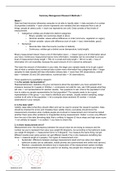Samenvatting
Summary Management Research Methods 1 - all exam material
- Instelling
- Universiteit Van Amsterdam (UvA)
Detailed summary Management Research Methods 1 (Premaster Business Administration) -> summary of all lectures and sheets, including important images, graphs and examples.
[Meer zien]





